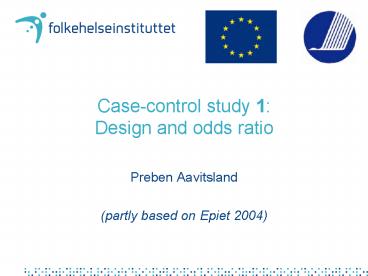Case-control study 1: Design and odds ratio - PowerPoint PPT Presentation
1 / 20
Title:
Case-control study 1: Design and odds ratio
Description:
... to acquire knowledge about causes and protective factors of disease. Both for outbreaks and endemic diseases. Easy to perform and analyse. Needs thorough planning ... – PowerPoint PPT presentation
Number of Views:51
Avg rating:3.0/5.0
Title: Case-control study 1: Design and odds ratio
1
Case-control study 1Design and odds ratio
- Preben Aavitsland
- (partly based on Epiet 2004)
2
Contents
- Monday 1
- Design Case-control study as a smarter cohort
study - The odds ratio
- Tuesday 2
- Choosing cases and controls
- Matching
- Power calculation
- Wednesday
- Case-control studies in outbreaks
- Thursday 3
- Bias and confounding
- Analysis
3
Why case-control study
- Best way to acquire knowledge about causes and
protective factors of disease - Both for outbreaks and endemic diseases
- Easy to perform and analyse
- Needs thorough planning
- Next step after surveillance and outbreak
investigations
4
Source population
5
The cohort study
exposed
unexposed
6
The cohort study
exposed
a
unexposed
b
7
The cohort study calculation
- Exposed I1 a / Nt1 16 / 125 pyar
- Unexposed I0 b / Nt0 8 / 120 pyar
- IRR I1 a / Nt1 16/125 pyar 1.92
- I0 b / Nt0 8/120 pyar
8
Problems of cohort
- Large sample size required
- At least if disease is rare
- Latency period
- Time consuming
- Loss to follow up
- Changing exposure over time
- Only one exposure
- Ethical considerations
- Cost
9
That is whythe case-control study is smarter
- Gives the same measure of causal effect as the
cohort study (risk ratio RR or incidence rate
ratio IRR) - It is called odds ratio (OR)
- Easier, quicker, cheaper, smarter
10
Source population
Exposed
Unexposed
The case-control study
11
Source population
Exposed
Cases
Unexposed
12
Source population
Exposed
Sample
Cases
Unexposed
Controls
13
Source population
Exposed
Sample
Cases
Unexposed
Cases the same as in cohort study Controls
sample of the source population, with
representative distribution of exposed and
unexposed persons (or person-time)
Controls
14
Source population
a
b
Exposed
Sample
Cases
Unexposed
c
d
Controls
15
Source population
a
b
Exposed
Sample
Cases
Unexposed
d / Nt0 c / Nt1 because sampled independent of
exposure 24 / 120 25 / 125
c
d
Controls
16
The case-control study calculation
- IRR I1 a / Nt1
- I0 b / Nt0
- a . Nt0
- b Nt1
- a . d
- b c
d c Nt0 Nt1 Nt0 d Nt1 c
16 . 24 1.9225 8
17
Saving resources with case-control study
- In stead of following a cohort of 245 people for
one year to wait for the 24 cases - We investigated the 24 cases in order to divide
them between - exposed a 16 and
- unexposed b 8
- We chose 49 controls and investigated them in
order to divide them between - exposed c 25 and
- unexposed d 24
- The result
- exactly the same as cohort study, but much easier
18
The odds ratio (OR)
- OR Incidence rate ratio (IRR)
- OR Risk ratio (RR)
- Cross product ratio ad / bc
19
Summary of the case-control study
- Imagine a source population
- Consists of exposed and unexposed people
- Gives rise to cases (same as if cohort study)
- Control group is a sample from this source
population - Independent of exposure status
- Same distribution of exposed persons
(person-time) as in source population - Determine exposure status of cases and controls
- Calculate odds ratio
- risk ratio or incidence rate ratio if a cohort
had been done
20
Challenges in case control study
- No measure of disease occurrence
- Not risk R or incidence rate IR
- Difficult to define source population
- Difficult to sample controls correctly
- Independently from exposure
- Recall bias
- Cases remember differently from controls































